What is the best way to pack a backpack? After carrying backpacks for decades, I feel I can provide an answer, so keep reading.
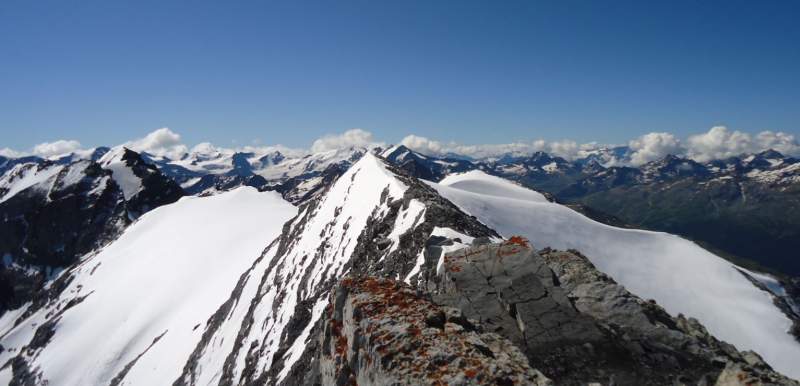
There are at least two different aspects/questions to consider when it comes to packing a backpacking, hiking, or mountaineering pack:
- How to load a backpack.
- How to organize a backpack.
There is a third question, and this is what to really carry in a pack, but this depends on the type of the tour, and I have addressed this issue in a separate text.
The present text is about larger packs. If you are on a short and fast day tour without much stuff to carry, you will be using a small day pack and it does not really matter how you pack it. The top picture above is from such a tour to Geisterspitze where I had my small Osprey Stratos 24 pack.
So back to the issues. The first of the mentioned questions deals with optimal stability and load distribution in the pack so that you can carry it in the most comfortable way.
The second question is about the optimal organization so that you can get to your gear in the easiest way. This will depend a lot on the type of pack of course. So let’s see some details related to these two questions.
But before I continue, perhaps you might want to know if I am really entitled to give instructions of this type. So, here are a few facts:
- I have been carrying mountaineering and hiking packs for close to 4 decades already.
- I am a theoretical physicist by profession, with more than 3 decades of work in exact science. So I know a bit about forces and in particular about gravity and how it acts on our body when we have a pack on the back.
How to load a backpack for an optimal load carry comfort
I just received my new Deuter Futura Vario 50 + 10 pack. I ordered it online, the price was extraordinary, so I could not resist. As it seems now, this series is finished, cannot see it on Deuter’s site. They have launched the Deuter Futura Air Trek with almost the same features. If you do not believe it, see my detailed comparison here.
Now, these packs are so sturdy that I am convinced my new Futura Vario will work great for the rest of my life. To realize what I mean, see these two photos below.
On the right is my 18 years old Futura pack which I used in climbing many of the mountains described here in the site. As you realize, the trampoline-style tensioned mesh on the back looks completely intact. The same holds for all the seams on the pack, simply amazing.
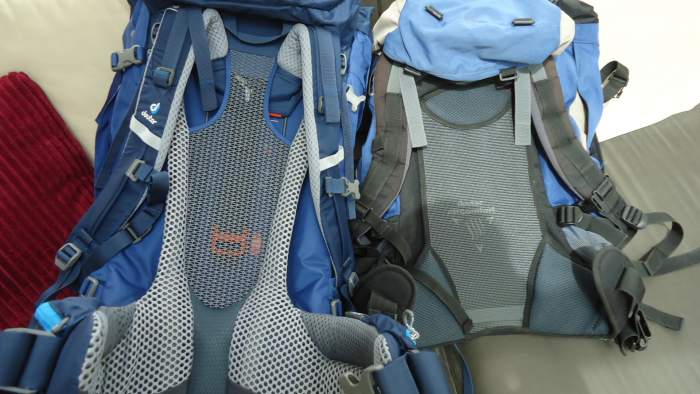
On the left is the new pack, and you realize how different the trampoline-style mesh now is. But the reason for mentioning this is the picture which I received with the pack. It is shown below and it will help to demonstrate what I want to say:
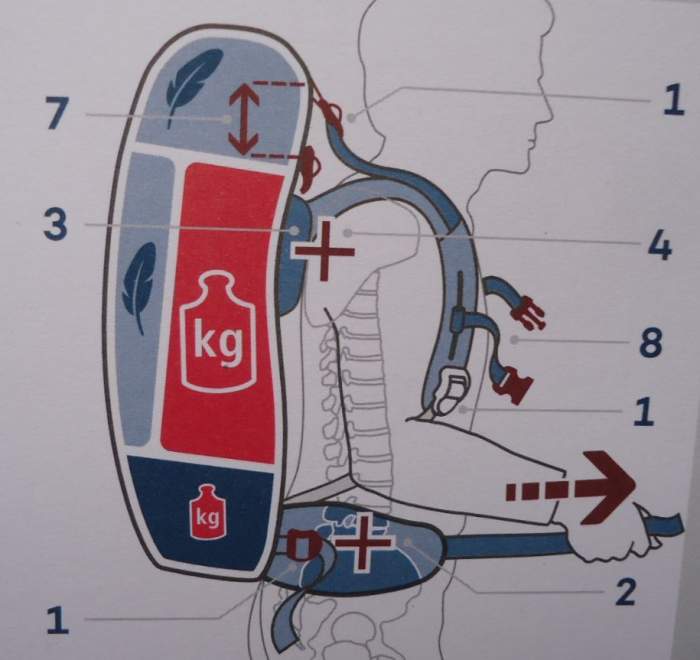
For the purpose of this text, it is best to ignore the numbers in the picture above, they are not important. What matters is the weight distribution shown in the pack. They presented it correctly. This is expected from such a brand, I wonder if you know that Deuter has been making packs since the 19th century.
I would warmly suggest that you try to memorize this picture and use the principles it describes whenever you load the pack. So here is what it shows:
- Put the heaviest items as close as possible to your body. This is the red area in the pack. As you know, packs usually have sleeves for the water bladder that is exactly behind the back panel. The water is usually the heaviest stuff that you carry. So now you know why the bladder is always there.
- Note that even in this case you can have differences depending on the type of terrain. On different slopes, we tend to lean forward differently when we have a load on the back. This is shown in the pictures below (both are from Deuter). You have i) on the left a flat terrain and the distribution of forces acting on the weight in the pack, and ii) on the right a steep and hard terrain.
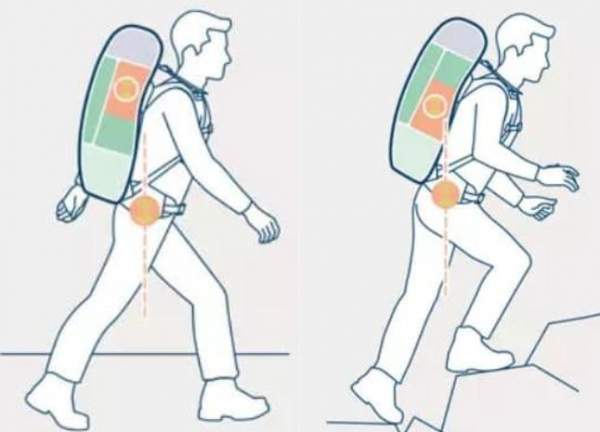
- As you realize, it is important that the center of gravity of the pack (represented by the yellow ring) is above the center of gravity of your body (represented by the orange circle in the hips area.
- So the heaviest items can be shifted a bit up or down so that the centers of gravity are on the same vertical line. This is all theory, I doubt that anybody really takes so much attention to this. But at least remember the general distribution shown above.
- A bit less heavy items can go to the bottom compartment, or on the bottom of the pack if it does not have a separate bottom compartment. Why? This is demonstrated below (the picture is from a document of Deuter).
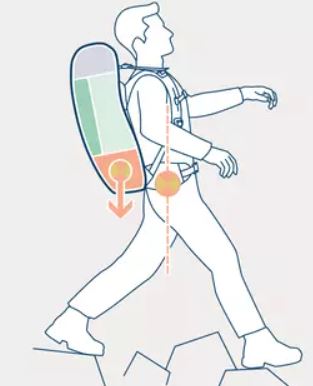
- The picture shows that such a weight in the bottom compartment forces you to walk too much upright. This is because of the momentum of the force acting on the center of gravity of the pack. It is proportional to the weight and the distance of the gravity center from the body. I told you, I have a Ph.D. in theoretical physics. As a result, this creates too much stress on the body muscles, in particular on your shoulders, and you will feel more tired.
- The lightest items will go to the periphery of the pack. This means on the top, and on the front of the pack. These areas are light blue in the starting picture above. This is why you can have bulky pockets on the front to store your pieces of clothing. For the same reasons, you can attach the sleeping pad in the same area or on the top of the pack. My Deuter Futura Vario 50 + 10 has four webbing loops for this purpose on the top of the lid, see them here:

- Avoid placing heavy stuff on the top. From the pictures above you realize that the body is naturally angled when you carry a pack. This is to counteract the weight of the pack. If you put heavy stuff on the top, the vertical center of gravity line will be shifted forward. This may compromise your stability and to balance this, you will have to use your muscles.
Harness adjustability
All that I mentioned above will not be enough if you do not carry the pack correctly. This means that the hip belt must hug your hip bones. The idea is that you carry most of the weight on the hip area and not on your shoulders. So how much really? I would say 100% but this is difficult to achieve in practice. So the answer is: as much as possible.
Nicely designed packs will have dual padding zones in the hip belt. See below how it looks in the Deuter Futura Vario pack. The same you can have in many packs of Osprey and Gregory.
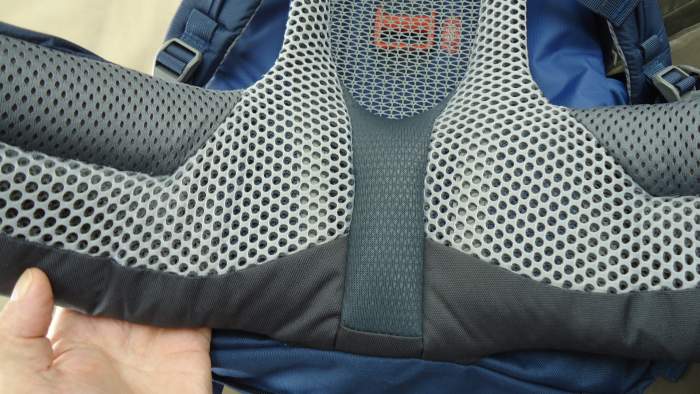
Ideally, your hip bones should be in the area where you have the separation between the two different padding sections. For this, it may be essential to have a pack that allows for continuous adjustability of the torso length. This means any length within a given range. See how this looks in my Deuter Futura Vario 50 + 10 Pack, the same system is in the new Deuter Futura Air Trek packs.
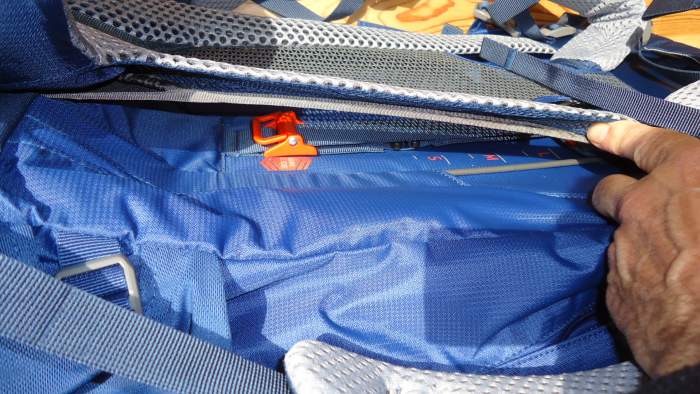
How to organize a pack
This may be more about functionality than about stability. But this is still a bit related to the issue discussed above, and it also depends on the design and construction of the pack.
I love to have many pockets, and the Deuter Futura Vario packs are among champions in this sense. For example, they offer the upper side bellows pockets, one is shown below. There are two of them on the sides.
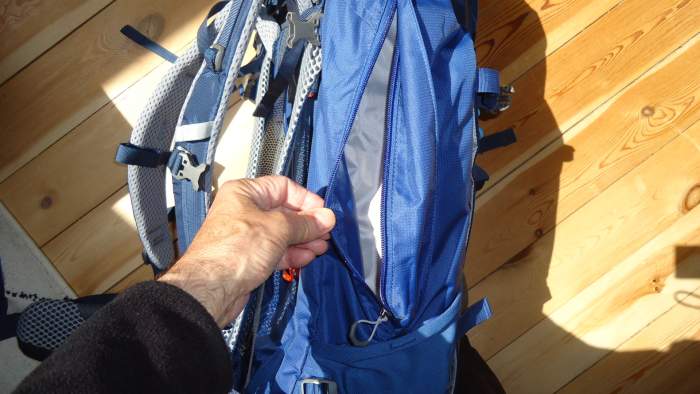
So it is good to put here stuff that you want to have close at hand, those that you might want to use on the trail during breaks etc. If so, try to distribute the load evenly in both pockets. They are big and they can be destabilizing if you have very different weights on the two sides. Otherwise, you may have a pack that moves left-right too much as shown in the picture below.
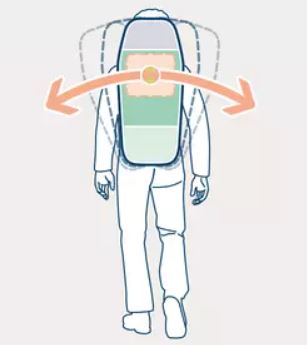
If you feel that the pack is shaking too much, use load lifter straps and bring the top of the pack closer to the body and stabilize it. Some packs also have straps on the side of the hip belt so that you can bring the pack closer to your body and it will feel more stable. Use side compression straps as well, this all helps.
When the pack is on your back, it should not move up when you lift your feet. If this happens, then the hip belt is not at the right height.
How much weight can you carry in the pack?
This question may have many answers. But to be clear, by this I mean to carry during your daily tour, no matter if this is a backpacking or mountaineering tour. This means for many hours, on uneven and rough terrain, etc.
I can’t answer in your name. I have read on Deuter’s site that in the German Federal Armed Forces this goes to up to 33% of the body weight.
This means a soldier that weighs 100 kg can carry 33 kg of the stuff in the pack. This is a lot, and I guess this depends on the type of pack. For extremely heavy loads, it is best to have a pack that is without the curvature which you have in those packs with a trampoline-style back panel.
I weigh below 70 kg, more precisely around 67, and if necessary, I can carry around 15 kg in the mentioned Deuter Futura Vario pack. But not so long ago, before I started my strict diet and reduced weight, I had 15 kg more.
So imagine how much stress this extra body weight puts on the heart. I discussed this in my texts about climbing Teide for the 7th and 8th time.
I also know that Deuter does not give the official weight capacity for their packs. But after many years of using their packs, I am sure they can withstand more than my knees.
How about you? Do share your thoughts below, there is a comment box. You might want also to see my text about hydration backpacks and also about ventilated packs.. Thank you for reading and have a nice day.
Leave a Reply